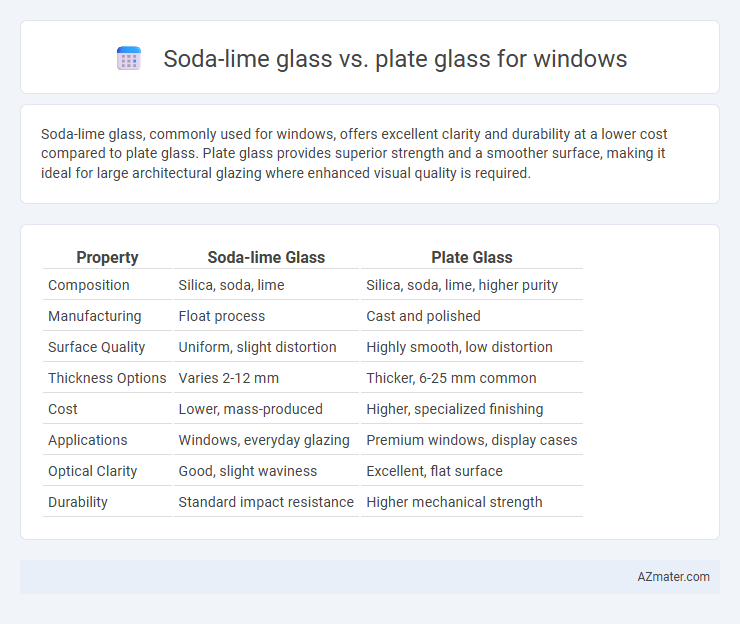Soda-lime glass, commonly used for windows, offers excellent clarity and durability at a lower cost compared to plate glass. Plate glass provides superior strength and a smoother surface, making it ideal for large architectural glazing where enhanced visual quality is required.
Table of Comparison
| Property | Soda-lime Glass | Plate Glass |
|---|---|---|
| Composition | Silica, soda, lime | Silica, soda, lime, higher purity |
| Manufacturing | Float process | Cast and polished |
| Surface Quality | Uniform, slight distortion | Highly smooth, low distortion |
| Thickness Options | Varies 2-12 mm | Thicker, 6-25 mm common |
| Cost | Lower, mass-produced | Higher, specialized finishing |
| Applications | Windows, everyday glazing | Premium windows, display cases |
| Optical Clarity | Good, slight waviness | Excellent, flat surface |
| Durability | Standard impact resistance | Higher mechanical strength |
Introduction to Soda-lime Glass and Plate Glass
Soda-lime glass, comprising about 70-75% silica, is the most common type of glass used in windows due to its affordability, ease of manufacture, and good optical clarity. Plate glass undergoes a grinding and polishing process to achieve a smooth, flat surface, making it ideal for high-quality window applications requiring precise thickness and optical performance. While soda-lime glass is often used for standard residential windows, plate glass is preferred in architectural settings where durability and aesthetic clarity are critical.
Composition and Manufacturing Processes
Soda-lime glass primarily consists of silica, soda ash, and lime, produced through a float glass process that melts raw materials at high temperatures and forms a continuous ribbon of glass on a molten tin bath, resulting in a smooth, uniform surface ideal for windows. Plate glass features a similar silica base but undergoes an additional grinding and polishing step after casting to produce a thicker, optically superior sheet commonly used in high-end window applications where clarity and flatness are critical. The manufacturing of soda-lime glass emphasizes cost-efficiency and mass production, while plate glass manufacturing involves more labor-intensive finishing to enhance durability and aesthetic quality.
Key Physical Properties Comparison
Soda-lime glass, composed primarily of silica, sodium oxide, and calcium oxide, offers moderate density (approximately 2.5 g/cm3) and a thermal expansion coefficient around 9 x 10^-6 /degC, making it suitable for standard window applications. Plate glass exhibits a similar density but typically provides enhanced flatness and surface smoothness due to its manufacturing process, resulting in improved optical clarity and lower distortion for premium window installations. Both types have comparable tensile strength (~50 MPa) and hardness (around 5.5 Mohs), but plate glass often undergoes additional treatments to increase impact resistance and reduce susceptibility to scratches.
Optical Clarity and Transparency Differences
Soda-lime glass, commonly used in residential windows, offers good transparency but may contain slight impurities affecting optical clarity compared to plate glass. Plate glass is manufactured through a controlled process that produces a smoother surface and fewer distortions, resulting in superior optical clarity ideal for commercial and high-precision applications. The enhanced transparency and minimal visual distortion of plate glass make it preferable for large-window installations requiring crystal-clear views.
Strength and Durability Aspects
Soda-lime glass, commonly used in windows, offers moderate strength and is prone to surface scratches and breakage under impact, whereas plate glass provides higher durability due to its thicker, uniform composition and superior resistance to mechanical stress. Plate glass windows maintain structural integrity longer in harsh weather conditions and are less likely to develop pressure-induced cracks compared to soda-lime glass. The enhanced strength of plate glass makes it suitable for applications requiring increased safety and longevity in architectural glazing.
Thermal and Acoustic Insulation Performance
Soda-lime glass offers moderate thermal insulation but falls short in acoustic performance compared to plate glass, which provides superior soundproofing due to its thicker, denser structure. Plate glass windows reduce heat transfer more effectively, enhancing energy efficiency by limiting thermal conductivity. For applications prioritizing both thermal and acoustic insulation, plate glass is the optimal choice due to its enhanced durability and sound attenuation properties.
Cost and Availability Considerations
Soda-lime glass is more cost-effective and widely available for window applications due to its simpler manufacturing process and abundant raw materials. Plate glass, often thicker and clearer, carries higher production costs and limited availability, making it less economical for large-scale residential projects. Choosing between soda-lime and plate glass hinges on budget constraints and the required optical quality for specific window designs.
Common Applications in Windows
Soda-lime glass is commonly used in residential windows due to its cost-effectiveness, ease of manufacturing, and good optical clarity. Plate glass, known for its superior strength and smoother surface, is often utilized in commercial building windows and storefronts where durability and aesthetic quality are prioritized. Both types are compatible with various treatments like tempering or laminating to enhance safety and thermal insulation in window applications.
Environmental Impact and Recycling
Soda-lime glass, commonly used in windows, has a lower environmental impact due to its higher recyclability and widespread recycling infrastructure compared to plate glass, which often contains impurities that complicate recycling processes. The energy consumption in producing soda-lime glass is generally lower, and its composition allows for efficient re-melting and reuse, reducing landfill waste. Plate glass, while offering clearer optical properties, typically results in higher processing emissions and less efficient recycling, contributing to greater environmental burden.
Which Glass Type Is Best for Your Window Needs?
Soda-lime glass is ideal for residential windows due to its cost-effectiveness, ease of manufacturing, and decent durability, making it a practical choice for typical home environments. Plate glass, characterized by its higher clarity and strength, suits commercial and architectural applications where aesthetics and impact resistance are critical. Selecting the best glass depends on factors like budget, clarity requirements, thermal efficiency, and the window's exposure to physical stress.

Infographic: Soda-lime glass vs Plate glass for Window
 azmater.com
azmater.com